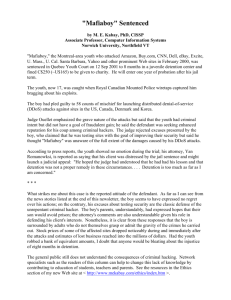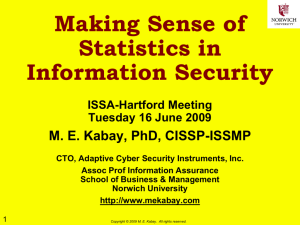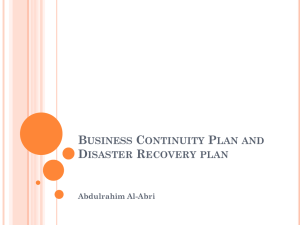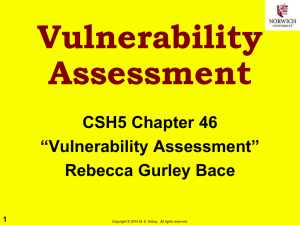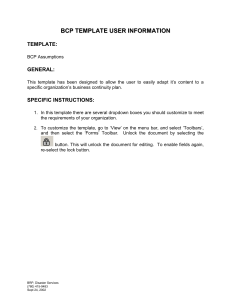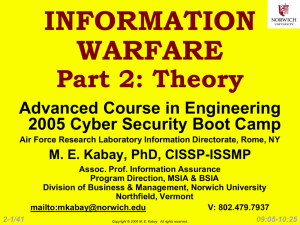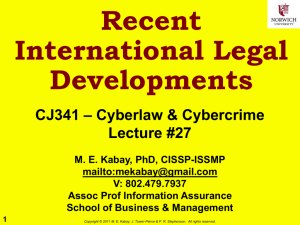Business Continuity Planning
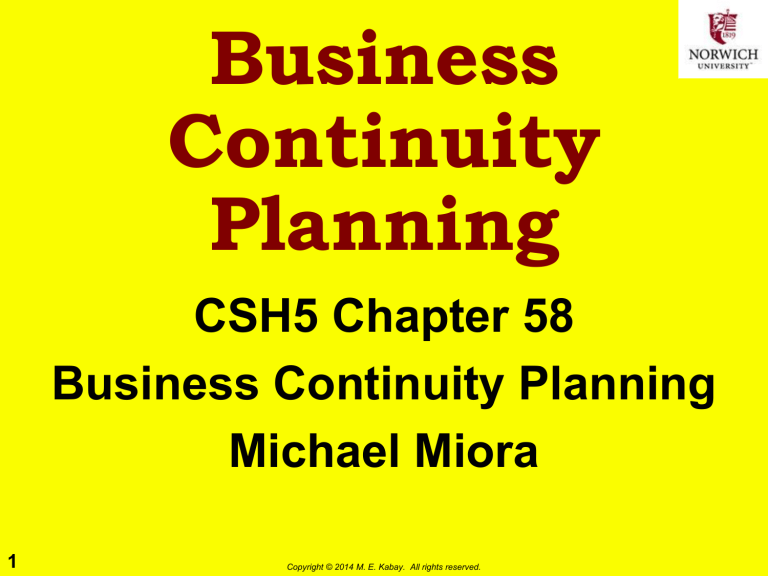
1
Business
Continuity
Planning
CSH5 Chapter 58
Business Continuity Planning
Michael Miora
Copyright © 2014 M. E. Kabay. All rights reserved.
2
Topics
Basic Concepts
Defining Goals of BCP
The BIA
BIA Matrix Analysis
Justifying Costs of BCP
Copyright © 2014 M. E. Kabay. All rights reserved.
(1992)
3
Basic Concepts of BCP
BCP and DRP
Overview
Enterprise Risks and Costs
Types of Disasters
Recovery Scenarios
Copyright © 2014 M. E. Kabay. All rights reserved.
4
BCP and DRP
Business Continuity Planning
Identifying critical functions
Developing the critical path for recovery
Evaluating costs
Gaining management approval
Disaster Recovery Planning
Preparing specific strategies for recovery
Defining specific tasks
(steps) needed to implement those strategies
Testing and revising
Copyright © 2014 M. E. Kabay. All rights reserved.
5
Overview
Increasing dependence on technology
Mission-critical systems
(production)
Development
Management
Business Continuity Planning
(BCP)
Protecting organizations against consequences of unavailability of such systems
Focus on enterprise operations, not just IT
Must define “fast enough”
In each context of the business
Copyright © 2014 M. E. Kabay. All rights reserved.
6
Enterprise Risks and Costs
Fundamental risk is to survival of organization
Case of La Ferme St
Laurent
Clients of Mathema in
Montréal in 1980s
Failed in 1986 when computer error caused them to stamp milk products with wrong expiry dates
Copyright © 2014 M. E. Kabay. All rights reserved.
Enterprise Risks and Costs
(cont’d)
Exhibits are from Michael Miora’s Chapter 42 in CSH4.
7
Copyright © 2014 M. E. Kabay. All rights reserved.
Types of Disasters
8
Copyright © 2014 M. E. Kabay. All rights reserved.
9
Types of Disasters (cont’d)
The specific disaster scenario is not as important as the recovery process and recovery time
Group disasters into
types to facilitate planning
Break BCPs into modules to activate as appropriate
Copyright © 2014 M. E. Kabay. All rights reserved.
Recovery Scenarios
Recovery scenarios have 3 phases
Exhibit 42.4
10
Determine the effect of the emergency
Major recovery steps
Copyright © 2014 M. E. Kabay. All rights reserved.
Restore normal ops
11
Topics
Basic Concepts
Defining Goals of BCP
The BIA
BIA Matrix Analysis
Justifying Costs of
BCP
Copyright © 2014 M. E. Kabay. All rights reserved.
12
Defining Goals of BCP
Overview
Scope
Correlating Objectives to
Corporate Missions and
Functions
Validating Goals
Mapping Goals to Recovery
Phases
Emergency Issues
Copyright © 2014 M. E. Kabay. All rights reserved.
13
Overview of Setting Goals
Setting goals a multi-step process
Define minimum service levels required for acceptable performance
Define specific goals for specific sectors
Gain approval and support of steering committees of appropriate sector
Gain overall approval of upper management
Goals are defined in business
terms not in terms of means and systems
Process may be iterative
Copyright © 2014 M. E. Kabay. All rights reserved.
14
Scope
Define environment to be protected
Who and what are to be included?
Will protect specific
systems,
equipment,
procedures,
locations, and
support capabilities
Expect to refine and redefine scope during planning process
May have to define stepwise (phased) implementation plan for BCP
Copyright © 2014 M. E. Kabay. All rights reserved.
15
Correlating Objectives to
Corporate Missions and Functions
IT often (usually) develops BCP
Systems engineering disciplines help
IT infrastructure critically important
May already have contacts throughout organization for functional support
Must expand beyond IT
Need business perspective
CIO is only one C-level exec
Much may depend on processes outside scope of IT function
Must not overlook non-IT-dependent systems
SCM and CRM go beyond automated systems
Copyright © 2014 M. E. Kabay. All rights reserved.
16
Corporate Missions and
Functions (cont’d)
Examples of often-overlooked functions
Mail room
Facilities support
Especially important in emergencies and for recovery
Security forces
Work from 3 main documents
Organization chart
Corporate phone directory
List of corporate operations budget line items
Copyright © 2014 M. E. Kabay. All rights reserved.
Missions and Functions (cont’d)
17
Exclude
Include
Copyright © 2014 M. E. Kabay. All rights reserved.
18
Validating Goals
Distinguish between importance of a function
To the overall corporate goals
To BCP / disaster recovery goals
Mostly a matter of timeline
Determine how long function can be suspended (or running at minimal levels) without harming organization
May change depending on circumstances
E.g., corporate tax function may be longterm goals at mid-year yet more critical at tax-filing time
Need top-management sign-off on fundamental goals – affects everything else
Copyright © 2014 M. E. Kabay. All rights reserved.
Mapping Goals to Recovery
Phases
19
Copyright © 2014 M. E. Kabay. All rights reserved.
20
Emergency Issues
Ensure safety of employees and others potentially affected by disaster
Health protection (gas masks, hazmat suits, etc. as appropriate)
Safety preparedness (fire extinguishers, training, CPR…)
Shelter & care for employees involved in disaster or in recovery
Search & rescue teams
Effective public relations may keep a problem from becoming a disaster
Honest, timely, accurate and controlled release of information
Copyright © 2014 M. E. Kabay. All rights reserved.
21
Topics
Basic Concepts
Defining Goals of BCP
The BIA
BIA Matrix Analysis
Justifying Costs of BCP
Copyright © 2014 M. E. Kabay. All rights reserved.
22
Establishing Scope of BIA
Inventory equipment & capabilities to be protected or recovered
Will change over time
Must be kept up-to-date
Remember communications infrastructure
Establish documentation
Office equipment may also be critical
Include security systems
Copyright © 2014 M. E. Kabay. All rights reserved.
Interviews
23
Copyright © 2014 M. E. Kabay. All rights reserved.
24
Interviews (cont’d)
People who do the work are the best sources of information about those functions
Determine whom to interview
List departments
Select individual in each dept as 1 ° interviewee
Determine functions within each department
Avoid excessive detail
Group means into functional goals
E.g., specific forms for SEC = “SEC reporting”
Copyright © 2014 M. E. Kabay. All rights reserved.
Interviews (cont’d)
Goal: develop chart showing relative
importance of different functions
Will be important in determining critical path
(timeline) for recovery
25
Copyright © 2014 M. E. Kabay. All rights reserved.
Describing Functions
Must include summary information about each function listed
1 or 2 ¶
Reduce confusion
Focus discussions
Use functional matrix as shown below to represent functions
Department Functions
Key
Person
Key
Alternate
Department
Head
System Elements
26
Copyright © 2014 M. E. Kabay. All rights reserved.
Definition of Departments &
Functions
Department Functions
Key
Person
Key
Alternate
Department
Head
System Elements
Survival Days
How long can organization survive without this function before significant damage?
27
Copyright © 2014 M. E. Kabay. All rights reserved.
Definition of Departments &
Functions (cont’d)
Criticality
What happens when the damage starts?
28
Copyright © 2014 M. E. Kabay. All rights reserved.
Definition of Departments &
Functions (cont’d)
Operational Impact
Convert criticality to Operational Impact
4 levels instead of 10
Reduces granularity of criticality
29
Copyright © 2014 M. E. Kabay. All rights reserved.
The Ranking Factor
Department Functions
Key
Person
Key
Alternate
Department
Head
System Elements
30
Combines survival time and operational impact
Low number is most important
Multiply survival time (days) x operational impact
E.g., 1 day survival x op impact critical (1) = 1
10 day survival x op 1 = 10
3 day survival x “some op impact” (3) = 9
Copyright © 2014 M. E. Kabay. All rights reserved.
Category
Department Functions
Key
Person
Key
Alternate
Department
Head
System Elements
Sort by Ranking Factor in ascending order
Category groups functions with similar recovery periods
31
Copyright © 2014 M. E. Kabay. All rights reserved.
Category (cont’d)
32
Copyright © 2014 M. E. Kabay. All rights reserved.
33
Topics
Basic Concepts
Defining Goals of BCP
The BIA
BIA Matrix Analysis
Justifying Costs of BCP
Copyright © 2014 M. E. Kabay. All rights reserved.
34
BIA Matrix is Heart of BIA
Basic information needed to
Establish recovery requirements
Timelines
Estimate costs of outages
Useful in
Translating business objectives into BIA objectives
Copyright © 2014 M. E. Kabay. All rights reserved.
Listing the Functions Organizationally
35
. . .
Copyright © 2014 M. E. Kabay. All rights reserved.
36
Finding Cross-Department
Functions
Emphasize similar functions in different departments
Titles may differ but functions same or almost
Especially important to resolve
different estimates of parameters
(Survival days, criticality, impact, ranking factor….)
Must adapt to irreconcilable perspectives
Copyright © 2014 M. E. Kabay. All rights reserved.
Cross-Department Functions
. . .
37
Copyright © 2014 M. E. Kabay. All rights reserved.
Using the Ranking Factor
. . .
38
Copyright © 2014 M. E. Kabay. All rights reserved.
Ranking Factor (cont’d)
Critically important functions that must be restored first
39
Copyright © 2014 M. E. Kabay. All rights reserved.
40
Topics
Basic Concepts
Defining Goals of BCP
The BIA
BIA Matrix Analysis
Justifying Costs of BCP
Copyright © 2014 M. E. Kabay. All rights reserved.
41
Quantitative Risk Model (QRM)
Annualized Loss Expectancies
ALE =
p i c i
p i is probability of event or strategy i
c i is cost (or gain) of event or strategy I
E.g., in roulette (gambling game),
Probability p
1 of winning $1 bet on a single number on 1 roll of wheel is 1/38 and gain c
1
36 times the bet = $36 is
Losing: p
2
= 37/38 with c
2
= -$1
So ALE for this bet is p
1 c
1
+ p
2 c
2
= 0.0263*$36 + 0.9737*(-$1)
= $0.9468 - $0.9737 = -$0.0269 per bet
Copyright © 2014 M. E. Kabay. All rights reserved.
42
Problems of the QRM
Costs depend on level of loss
E.g., costs will rise as outage lengthens
Complicates calculations
Most important: exact probabilities difficult to determine
Some events have extensive data base
Actuaries keep records for insurance companies – fire, flood, etc.
But IT-related probabilities difficult to find
Huge variations in infrastructure, configuration, exposure to threats
Operational standards affect vulnerabilities
Copyright © 2014 M. E. Kabay. All rights reserved.
43
Generalized Cost
Consequence Model (GCC)
Estimate cost of damage for each function
When does the loss begin?
What are the monetary consequences?
Apply cost when appropriate
Collect costs by category
Copyright © 2014 M. E. Kabay. All rights reserved.
GCC (cont’d)
Evaluate total losses day-by-day
44
Copyright © 2014 M. E. Kabay. All rights reserved.
GCC (cont’d)
Estimate costs with Disaster Recovery Plan in place and compare to costs without DRP
45
Copyright © 2014 M. E. Kabay. All rights reserved.
46
Review Questions (1)
1. Distinguish between BCP and DRP
2. Why is BCP important to IT today?
3. What is the advantage of grouping disasters into types in BCP?
4. What are the three phases of recovery scenarios?
5. Why do you need BCP steering committees for different sectors of the organization? Why can’t a BCP expert simply define the goals of the process herself?
6. How does defining the scope of the BCP support the planning process?
7. Why does the IT sector so often get the responsibility for coordinating BCP?
Copyright © 2014 M. E. Kabay. All rights reserved.
47
Review Questions (2)
8. What are the 3 main documents recommended by Prof
Miora as the basis for identifying key corporate functions?
9. In the description of functions for the functional matrix, what does the criticality score signify?
10. What is the relation between the operational impact score and the criticality score in the functional matrix?
11. In the functional matrix, how is the ranking factor calculated? What is the ranking factor used for?
12. In the functional matrix, what is the relation between the category and the ranking factor? What is the
category used for?
13.
What’s the benefit of listing functions organizationally in the BIA matrix?
Copyright © 2014 M. E. Kabay. All rights reserved.
Review Questions (3)
14. How does sorting by ranking factor in the BIA matrix serve
BCP needs?
15. A fire-insurance policy costs Megahard Corp $10,000 per year for the Miora Complex on the Northfield Campus to cover the $8,000,000 cost of rebuilding it were it to burn down. Actuaries inform the risk managers at Megahard that the probability of a catastrophic fire is 0.001 per year.
Calculate the ALE of the insurance policy and then calculate the ALE of total destruction of the building; compare the two numbers. Is the insurance policy cost-effective? (Hint: in the insurance contract, Megahard bets the insurance company that they will have to pay out $8,000,000 and the insurer bets that they will not pay anything).
16. Why is it so difficult to apply the quantitative risk model to
BCP?
48
17. How does the Generalized Cost Consequence model support
BCP?
Copyright © 2014 M. E. Kabay. All rights reserved.
DISCUSSION
49
Copyright © 2014 M. E. Kabay. All rights reserved.
